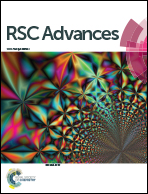Steering photoinduced charge kinetics via anionic group doping in Bi2MoO6 for efficient photocatalytic removal of water organic pollutants†
Abstract
In this work, we report a novel anionic group doped Bi2MoO6 with noble metal loading as an excellent photocatalytic material for the efficient photodegradation of organic pollutants, including rhodamine B (RhB) and colorless o-phenylphenol (OPP). Several characterization techniques were conducted to investigate the effect of anionic group doping and noble metal loading on the lattice structure, electronic structure, defect chemistry as well as photocatalytic performance. It's found that CO32− doping in a Bi2MoO6 host matrix led to lattice expansion, local symmetry distortion, oxygen vacancy generation and band gap narrowing from ∼2.60 to ∼2.31 eV. VB-XPS, Mott–Schottky plots and DFT results indicated that the variation of the band gap energy for Bi2MoO6 mainly originated from the upward shift of the valence band edge, which is attributed to the presence of the midgap states of the C 1s orbital. Noble metals (Au, Ag and Pd) as cocatalysts forcefully improved the photogenerated charge separation. With contributions from the doping effects and cocatalysts, the photocatalytic activity of 0.5% Pd–3C/BMO was robustly enhanced about 5-fold for RhB degradation within 40 min under UV + visible light irradiation and 29-fold for OPP degradation within 120 min under visible light irradiation in comparison with pristine Bi2MoO6, respectively.



 Please wait while we load your content...
Please wait while we load your content...